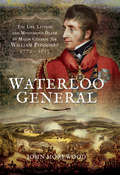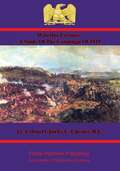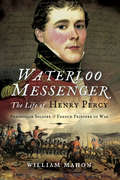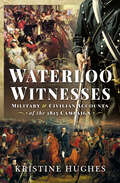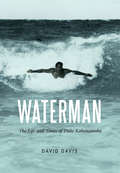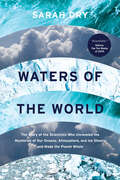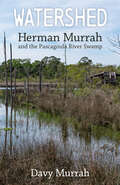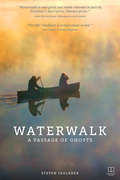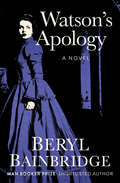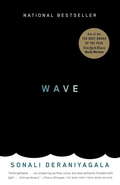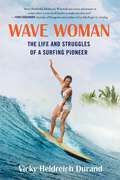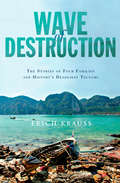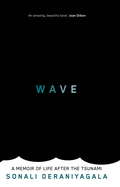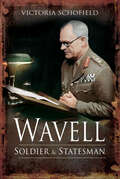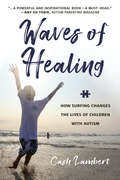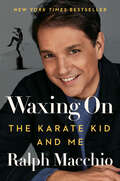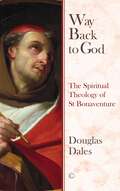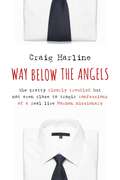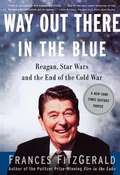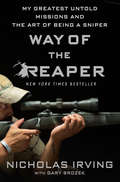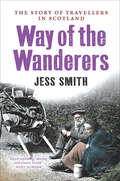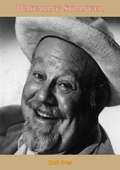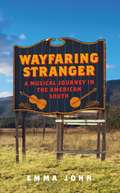- Table View
- List View
Waterloo General: The Life, Letters and Mysterious Death of Major General Sir William Ponsonby, 1772–1815
by John MorewoodThe defeat of Napoleons French army by the combined forces of Wellington and Blcher at Waterloo on 18 June 1815 was a turning point in world history. This was the climax of the Napoleonic Wars, and the outcome had a major influence on the shape of Europe for the next century and beyond. The battle was a milestone, and it cannot be properly understood without a detailed, on-the-ground study of the landscape in which it was fought and that is the purpose of David Butterys new battlefield guide. In vivid detail, using eyewitness accounts and an intimate knowledge of the terrain, he reconstructs Waterloo and he takes the reader and the visitor across the battleground as it is today. He focuses on the pivotal episodes in the fighting the day-long struggle for the chateau at Hougoumont, the massive French infantry assaults, repeated cavalry charges, the fall of La Haye Sainte, the violent clashes in the village of Plancenoit, the repulse of the Imperial Guard and rout of the French army. This thoroughgoing, lucid, easy-to-follow guide will be a fascinating introduction for anyone who seeks to understand what happened on that momentous day, and it will be an essential companion for anyone who explores the battlefield in Belgium.
Waterloo Lectures: A Study Of The Campaign Of 1815
by Lt.-Colonel Charles C. Chesney R.E.This ebook is purpose built and is proof-read and re-type set from the original to provide an outstanding experience of reflowing text for an ebook reader. Waterloo Illustration Pack - 14 maps/battle plans, 18 portraits of the personalities engaged, 10 illustrations. The Waterloo campaign of 1815 was a turning point in world history. After 25 years of almost constant warfare that raged from India to Canada, from South America to the Caribbean, peace among the European powers was decided on a small strip of land in modern day Belgium. The momentous fruits of the campaign have led to the decisions and actions of the belligerents and their armies to be argued back and forth ever since. Colonel Chesney's work is amongst a handful of books that are considered to be "standard" as histories of the campaign that have been translated into French and German. It is fitting that the work of such a learned soldier, who is also a late professor of Military Art and History at the Staff College in Camberley, should be such a balanced and detailed account of the campaign. This ebook is based on the 4th edition which includes all of the changes that Colonel Chesney wished to be incorporated until his untimely death and was published posthumously. Title - Waterloo Lectures: A Study Of The Campaign Of 1815 (4th Edition) Author -- Lt.-Colonel Charles C. Chesney R.E. (1826-1876) Text taken, whole and complete, from the edition published in 1907, London, by Longmans, Green and Co. Original - xiv and 251 pages. Illustrations - The original map cannot be provided with this edition due to its A3 size - We have added our Waterloo Illustration pack to ensure that the reader can follow the text.
Waterloo Messenger: The Life of Henry Percy: Peninsular Soldier & French Prisoner of War
by William MahonAt the Battle of Waterloo Sir William Ponsonby, a man who the Duke of Wellington stated had rendered very brilliant and important services and was an ornament to his profession, was killed by French lancers after leading the Union Brigade (the three Dragoon Regiments of the Royals, Iniskillings and Scots Greys) in a charge that wrecked a French advance that threatened Wellington with defeat. Sir William was a career soldier who had led his regiment in the decisive charge at the Battle of Salamanca and served with great distinction during the Peninsular War. Yet historians have blamed him because the charge at Waterloo got out of hand. In this book John Morewood uses family sources, including Sir Williams letters, as well as French and German accounts, to restore his reputation and, by shedding new light on the battle, establishes what really happen to him on that fatal afternoon. It is also a biography of a man whose bravery and professionalism distinguished him as one of the outstanding cavalry commanders of the age.
Waterloo Witnesses: Military and Civilian Accounts of the 1815 Campaign
by Kristine HughesThe events of Sunday, 18 June, stand as the defining moment of the year 1815, if not of an entire era. The allied victory over Napoleon’s French army at the Battle of Waterloo reshaped governments and boundaries, made or broke fortunes and touched thousands of lives in ways both large and small, and it has been analysed, dissected and refought on paper a hundred times. Perhaps, though, the very best words ever written about that momentous campaign are the first-person accounts recorded as events unfolded. It is these vivid accounts that Kristine Hughes has collected together in order to convey the hopes, fears and aspirations of their authors. They inject the story of the battle with a level of humanity that reclaims it from the realm of legend and restores it to the people who witnessed it. In chronological order her work pieces together a novel view of the battle and events surrounding it as they were experienced by both military men and civilians. The result is a fascinating and varied picture of the individuals involved and the society of the period. Their words make compelling reading.
Waterman: The Life and Times of Duke Kahanamoku
by David DavisWaterman is the first comprehensive biography of Duke Kahanamoku (1890–1968): swimmer, surfer, Olympic gold medalist, Hawaiian icon, waterman.Long before Michael Phelps and Mark Spitz made their splashes in the pool, Kahanamoku emerged from the backwaters of Waikiki to become America’s first superstar Olympic swimmer. The original “human fish” set dozens of world records and topped the world rankings for more than a decade; his rivalry with Johnny Weissmuller transformed competitive swimming from an insignificant sideshow into a headliner event.Kahanamoku used his Olympic renown to introduce the sport of “surf-riding,” an activity unknown beyond the Hawaiian Islands, to the world. Standing proudly on his traditional wooden longboard, he spread surfing from Australia to the Hollywood crowd in California to New Jersey. No American athlete has influenced two sports as profoundly as Kahanamoku did, and yet he remains an enigmatic and underappreciated figure: a dark-skinned Pacific Islander who encountered and overcame racism and ignorance long before the likes of Joe Louis, Jesse Owens, and Jackie Robinson.Kahanamoku’s connection to his homeland was equally important. He was born when Hawaii was an independent kingdom; he served as the sheriff of Honolulu during Pearl Harbor and World War II and as a globetrotting “Ambassador of Aloha” afterward; he died not long after Hawaii attained statehood. As one sportswriter put it, Duke was “Babe Ruth and Jack Dempsey combined down here.”In Waterman, award-winning journalist David Davis examines the remarkable life of Duke Kahanamoku, in and out of the water.
Waters of the World: The Story of the Scientists Who Unraveled the Mysteries of Our Oceans, Atmosphere, and Ice Sheets and Made the Planet Whole
by Sarah DryA Nature Top Ten Book of the Year: “Immensely readable” accounts of seven pioneers who were at the forefront of what we now call climate science (New York Review of Books).One of Booklist’s Top Ten Sci-Tech Books of the YearFrom the glaciers of the Alps to the towering cumulonimbus clouds of the Caribbean and the unexpectedly chaotic flows of the North Atlantic, Waters of the World is a tour through 150 years of the history of a significant but underappreciated idea: that the Earth has a global climate system made up of interconnected parts, constantly changing on all scales of both time and space. A prerequisite for the discovery of global warming and climate change, this idea was forged by scientists studying water in its myriad forms. This is their story.Linking the history of the planet with the lives of those who studied it, Sarah Dry follows the remarkable scientists who summited volcanic peaks to peer through an atmosphere’s worth of water vapor, cored mile-thick ice sheets to uncover the Earth’s ancient climate history, and flew inside storm clouds to understand how small changes in energy can produce both massive storms and the general circulation of the Earth’s atmosphere. Each toiled on his or her own corner of the planetary puzzle. Gradually, their cumulative discoveries coalesced into a unified working theory of our planet’s climate.We now call this field climate science, and in recent years it has provoked great passions, anxieties, and warnings. But no less than the object of its study, the science of water and climate is—and always has been—evolving. By revealing the complexity of this history, Waters of the World delivers a better understanding of our planet’s climate at a time when we need it the most.“One of the richest books I have ever read . . . a beautifully written, episodic, yet comprehensive, history of the diverse scientific underpinnings of climate science over the past two hundred years.” —Environmental History“Smart, compelling, and timely . . . By focusing on specific scientists, Dry gifts readers with entertaining portraits of some thoroughly interesting if largely unknown individuals.”—Booklist (starred review)
Watershed: Attending to Body and Earth in Distress
by Ranae Lenor HansonA personal health crisis, stories from environmental refugees, and our climate in danger prompt a meditation on intimate connections between the health of the body and the health of the ecosystem The body of the earth, beset by a climate in crisis, experiences drought much like the human body experiences thirst, as Ranae Lenor Hanson&’s body did as a warning sign of the disease that would change her life: Type 1 diabetes. What if we tended to an ailing ecosystem just as Hanson learned to care for herself in the throes of a chronic medical condition. This is the possibility explored in a work that is at once a memoir of illness and health, a contemplation of the surrounding natural world in distress, and a reflection on the ways these come together in personal, local, and global opportunities for healing.Beginning with memories from a childhood nurtured among the waters of Minnesota, Watershed follows the streams and tributaries that connect us to our world and to each other, as revealed in the life stories of Hanson&’s students, Minnesotans driven from their faraway homelands by climate disruption. The book&’s currents carry us to threatened mangrove swamps in Saudi Arabia, to drought-stricken Ethiopia, to rocks bearing ancient messages above crooked rivers in northern Minnesota, to a diabetic crisis in an ICU bed at a St. Paul hospital. With the benefit of gentle insight and a broad worldview, Hanson encourages us at every turn to find our own way, to discover how the health of our bodies and the health of the world they inhabit are inextricably linked and how attending, and tending, to their shared distress can lead to a genuine, grounded wellbeing. When, in the grip of a global pandemic, humans drastically change their behavior to preserve human life, we also see how the earth breathes more freely as a result. In light of that lesson, Watershed helps us to consider our place and our part in the health and healing of the world around us.
Watershed: Herman Murrah and the Pascagoula River Swamp
by Davy MurrahThe Pascagoula River is the largest unobstructed river in the contiguous United States. Because of this lack of restraint, the river has been left to rise and fall naturally with the seasons, overflowing annually into the adjoining bottomland forest. This phenomenon makes the Pascagoula River one of the wildest rivers, surrounded by some of the most ecologically diverse woodlands, in North America.Herman Murrah (1935–2002) lived his entire life on the banks and in the swamp surrounding this river in southeast Mississippi. Watershed: Herman Murrah and the Pascagoula River Swamp recounts pivotal moments in Herman’s life and in Mississippi’s conservation history more broadly. In this book, Herman’s eldest son, Davy, details the adventures that continue to inspire young conservationists in the fight to protect our remaining natural ecosystems.As a young adult, Herman worked as a game warden in the Pascagoula River Swamp. When the Pascagoula Hardwood Company, then owners of the swamp, decided to sell the vast tract of forest for clearcutting, Herman was incensed. Determined to protect this natural wonder, Herman teamed up with other visionaries to persuade the State of Mississippi to purchase the land and preserve it in perpetuity to the benefit of future generations of humans and wildlife alike. Eventually, the state agreed and finalized the purchase. Herman was appointed area manager for the upper portion of the newly designated Pascagoula River Wildlife Management Area. He dedicated the remainder of his life to preserving, protecting, and improving the swamp for the good of south Mississippi.
Waterwalk: A Passage Of Ghosts
by Steven FaulknerSteven Faulkner and his 16-year-old son Justin are paddling and portaging their way along the 1000-mile, 1673, Mississippi discovery route of French explorers Marquette and Joliet. Tired, hungry, lost, lonely, fogbound, canoe-wrecked, unable to make their way in the darkness, they are having an excellent time—paddling 300 miles along Lake Michigan’s shore to Green Bay, Wisconsin, then 300 miles up the storm-flooded Fox River, down the Wisconsin River, then turning south for 400 miles down the mighty Mississippi to St. Louis. Waterwalk is a triple journey: a journey into the heart of this continent 300 years ago—as depicted in Marquette’s own journal (a translation of which Faulkner found in the basement of a University of Kansas library), a modern exploration of the quiet waterways that weave their way through busy, rush-around America, and a voyage through the heart of a father-son relationship.“Something in us,” says Faulkner, “longs to go the way of the river, to lie down on those silken currents and swing away from the bank and move along mile after mile. There’s something there that’s wild and strong and asleep in mystery . . .And all the while, rivers spoke to us in unfamiliar languages, the winds warned us of unheeded perils, statues came alive and shared their stories, and a father and son tried to learn the language of friendship and interdependence."
Watson's Apology: A Novel
by Beryl BainbridgeA novel of marital bickering--and murder--based on a historical case in Victorian England, from the bestselling author of The Birthday Boys. In the winter of 1884, John Selby Watson, a clergyman and headmaster living in London, writes a series of love letters--including a marriage proposal--to a woman he met only briefly at a social gathering many years before. Though Anne Armstrong does not remember Watson, she is desperate to escape poverty and the miserable life she shares with her sister in a moldy Dublin boarding house. So she accepts. Despite the abrupt circumstances of their engagement--and Anne's initial distaste for her betrothed--several years of happy marriage follow. But Watson soon becomes entrenched in his studies of classical literature, leaving his wife feeling alienated and dejected. Trivial disputes agitate the couple's domestic life with increasing frequency--a letter goes missing, the page of a book gets stained--until the bickering erupts into full-blown abuse and, during a night of drinking, their toxic environment reaches its destructive climax. Based on a real nineteenth-century murder case, Watson's Apology is a speculative novel about the complex psychological motivations that underlie a seemingly straightforward domestic tragedy. Using dark irony and twisted humor, award-winning British author Beryl Bainbridge reveals the terror that resides in the banal, and the suspense that can be found in the mysteries of the mind and heart.
Wave
by Sonali DeraniyagalaOn the morning of December 26, 2004, on the southern coast of Sri Lanka, Sonali Deraniyagala lost her parents, her husband, and her two young sons in the tsunami she miraculously survived. In this brave and searingly frank memoir, she describes those first horrifying moments and her long journey since. She has written an engrossing, unsentimental, beautifully poised account: as she struggles through the first months following the tragedy, furiously clenched against a reality that she cannot face and cannot deny; and then, over the ensuing years, as she emerges reluctantly, slowly allowing her memory to take her back through the rich and joyous life she's mourning, from her family's home in London, to the birth of her children, to the year she met her English husband at Cambridge, to her childhood in Colombo; all the while learning the difficult balance between the almost unbearable reminders of her loss and the need to keep her family, somehow, still alive within her.
Wave Woman: The Life and Struggles of a Surfing Pioneer
by Victoria Heldreich DurandWave Woman is the untold story of an adventurer whose zest for life and learning kept her alive for ninety-eight years. Betty Pembroke Heldreich Winstedt was the granddaughter of Mormon pioneers who, after spending an active and athletic childhood in Salt Lake City, moved to Santa Monica with her family and enrolled at USC to study dental hygiene. Betty went on to elope with a man she hardly knew, and to have two daughters. In middle age, Betty finally followed her dream of living near the ocean; she moved to Hawaii and, at age forty-one, took up surfing. She lived and surfed at Waikiki during the golden years of the mid-1950s and was a pioneer surfer at Makaha Beach. She was competitive in early big-wave surfing championships and was among the first women to compete in Lima, Peru, where she won first place. Betty was an Olympic hopeful, a pilot, a mother, a sculptor, a jeweler, a builder, a fisherwoman, an ATV rider, and a potter who lived life her way, dealing with adversity and heartache on her own stoic terms. A love letter from a daughter to her larger-than-life mother, Wave Woman will speak to any woman searching for self-confidence, fulfillment, and happiness.
Wave of Destruction: The Stories of Four Families and History's Deadliest Tsunami
by Erich KraussThis exquisitely written book puts a human face on the tragedy of 2004's Southeast Asian tsunami through the heartbreaking and heroic stories of four who survived this cataclysmic natural disaster.Erich Krauss arrived in the Thai village of Nam Keam on a relief truck 12 days after an underwater earthquake of unimaginable magnitude erupted across the ocean floor and unleashed a tsunami that destroyed millions of lives and decimated the coastline of Southeast Asia. Wandering around the wreckage in a contamination suit, trying to deliver food and water, he found survivors desperate to tell him what their village had been like and how their lives had been changed forever. In Wave of Destruction, Krauss shares the pain and privation of four villagers who made it through alive only to bury their family and friends.Beginning with their fight for life as a 40-foot wave crashed down upon their community, and ending with their slow, confusing quest to rebuild after the last of the bodies had been buried, Krauss unveils the actions and thoughts of ordinary people who were forced to brave extraordinary circumstances. Krauss, a gifted writer and expert in Thai culture, allows the reader to experience one of the worst disasters the world has ever known—through the eyes of those who will never be able to forget.
Wave: A Memoir of Life After the Tsunami
by Sonali DeraniyagalaThe book opens and we are inside the wave: thirty feet high, moving at twenty-five mph, racing two miles inland. And from there into the depths of the author's despair: how to live now that her life has been undone? Sonali Deraniyagala tells her story - the loss of her two boys, her husband, and her parents - without artifice or sentimentality. In the stark language of unfathomable sorrow, anger, and guilt: she struggles through the first months following the tragedy -- someone always at her side to prevent her from harming herself, her whole being furiously clenched against the reality she can't face; and then reluctantly emerging and, over the ensuing years, slowly allowing her memory to function again. Then she goes back through the rich and joyous life she's mourning, from her family's home in London, to the birth of her children, to the year she met her English husband at Cambridge, to her childhood in Colombo while learning the balance between the almost unbearable reminders of her loss and her fundamental need to keep her family, somehow, still with her.
Wavell: Soldier and Statesman
by Victoria SchofieldArchibald Wavells life and career makes a marvelous subject. Not only did he reach the highest rank (Field Marshal) and become an Earl and Viceroy of India but his character was complex. He joined the Black Watch in 1901. He stood out during the Great War, quickly earning the Military Cross but losing an eye. He was at Versailles in 1918 but between the Wars his career advanced with Brigade and General commands notably in Palestine where he spotted Orde Wingate. By the outbreak of war he was GOC-in-C Middle East. Early successes against the Italians turned into costly failures in Greece and Crete and Wavell lost the confidence of Churchill; their temperaments differed completely. Wavell was sent to India as C-in-C. After Pearl Harbor Wavell was made Supreme Allied Commander for the SW Pacific and bore responsibility for the humiliating loss of Singapore (he quickly recognized that it could not be held). Problems in Burma tested Churchills patience and he was removed from command to be Viceroy and Governor General of India. As civil unrest and demands for independence grew, in 1947 Prime Minister Attlee replaced Wavell with Mountbatten who oversaw Partition. Wavell died in 1950, after a life of huge achievement tempered with many reverses, most of which were not of his making.
Waves of Healing: How Surfing Changes the Lives of Children with Autism
by Cash Lambert“Stand up, up, UP!” is the mantra of Surfers for Autism, an organization that runs surf events for children with autism, providing the opportunity to not only catch waves, but to become part of a supportive surfing community. It is also a message to all those struggling with autism: a message to stand up, no matter how hard it gets. Waves of Healing collects the stories of a group of everyday families who discovered Surfers for Autism in their search for hope, answers, and healing for their children with autism.These are stories about the struggles children with autism face—the struggle to stand on a surfboard, the struggle to communicate, the struggle to make progress in a world which accepts “normal” and rejects all else. But they’re also stories of breakthroughs, of authentic joy and unbridled excitement as they learn to see their world from a whole new perspective—standing tall atop a surfboard, riding a wave all their own.Exploring new avenues of therapy for those with autism, with therapeutic and extraordinary results, Waves of Healing is a snapshot of hope, courage, and human perseverance.
Waxing On: The Karate Kid and Me
by Ralph MacchioSince The Karate Kid first crane-kicked its way into the pop culture stratosphere in June 1984, there hasn’t been a week Ralph Macchio hasn’t heard friendly shouts of “Wax on, wax off” or “Sweep the leg!” Now, with Macchio reprising his role as Daniel LaRusso in the #1 ranked Netflix show Cobra Kai, he is finally ready to look back at this classic movie and give the fans something they’ve long craved. <p><p>The book will be Ralph Macchio’s celebratory reflection on the legacy of The Karate Kid in film, pop culture, and his own life. It will be a comprehensive look at a film that shaped him as much as it influenced the world. Macchio will share an insider's perspective of the untold story behind his starring role—the innocence of the early days, the audition process, and the filmmaking experience—as well as take readers through the birth of some of the film’s most iconic moments. <p><p>Ultimately, the book centers on the film itself, focusing on the reason that the characters and themes have endured in such a powerful way and how these personal experiences have impacted Macchio's life. It will bring readers back to the day they met Daniel LaRusso and Mr. Miyagi for the first time, but will also provide a fascinating lens into how our pasts shape all of us and how the past can come back to enrich one's life in surprising and wonderful ways. <p> <b>New York Times Bestseller</b>
Way Back to God: The Spiritual Theology of Saint Bonaventure
by Douglas DalesBonaventure was a great pastor and preacher, and also a very effective teacher. His writing shows clarity and conviction, and his authority arose from his profound grasp of Scripture and patristic monastic tradition. The force behind how he wrote sprang from his keen sense of the significance of Francis and Clare and all that flowed from them, not least into his own spiritual life and experience as a person of deep contemplative and mystical prayer. <p><p>Way Back to God is a comprehensive conspectus and study of how Bonaventure taught Christian theology and applied it to spiritual life. It is intended to be a guide through most of his writings (though not as a substitute for reading them). It provides a bridge into his thought, and also a remarkable hand-book of Christian theology in its bearing upon spiritual life. <p><p>Douglas Dales' new work enables Bonaventure's distinctive spiritual theology to be seen as a whole, as well as making his writings, in Latin or English, accessible and attractive.
Way Below the Angels: The Pretty Clearly Troubled But Not Even Close to Tragic Confessions of a Real Live Mormon Missionary
by Craig HarlineWhen Craig Harline set off on his two-year Mormon mission to Belgium in the 1970s, he had big dreams of doing miracles, converting the masses, and coming home a hero. What he found instead was a lot of rain and cold, one-sentence conversations with irritated people, and silly squabbles with fellow missionaries.From being kicked -- literally -- out of someone's home to getting into arguments about what God really wanted from Donny Osmond, Harline faced a range of experiences that nothing, including his own missionary training, had prepared him for. He also found a wealth of friendships with fellow Mormons as well as unconverted locals and, along the way, gained insights that would shape the rest of his life.Part religious history, part coming-of-age story, part witty spiritual memoir, this book takes readers beyond the stereotypical white shirts and name tags to reveal just how unpredictable, funny, and poignant the missionary life can be.
Way Out There in the Blue: Reagan, Star Wars and the End of the Cold War
by Frances FitzgeraldWay Out There in the Blue is a major work of history by the Pulitzer Prizewinning author of Fire in the Lake. Using the Star Wars missile defense program as a magnifying glass on his presidency, Frances FitzGerald gives us a wholly original portrait of Ronald Reagan, the most puzzling president of the last half of the twentieth century. Reagan's presidency and the man himself have always been difficult to fathom. His influence was enormous, and the few powerful ideas he espoused remain with us still -- yet he seemed nothing more than a charming, simple-minded, inattentive actor. FitzGerald shows us a Reagan far more complex than the man we thought we knew. A master of the American language and of self-presentation, the greatest storyteller ever to occupy the Oval Office, Reagan created a compelling public persona that bore little relationship to himself. The real Ronald Reagan -- the Reagan who emerges from FitzGerald's book -- was a gifted politician with a deep understanding of the American national psyche and at the same time an executive almost totally disengaged from the policies of his administration and from the people who surrounded him. The idea that America should have an impregnable shield against nuclear weapons was Reagan's invention. His famous Star Wars speech, in which he promised us such a shield and called upon scientists to produce it, gave rise to the Strategic Defense Initiative. Reagan used his sure understanding of American mythology, history and politics to persuade the country that a perfect defense against Soviet nuclear weapons would be possible, even though the technology did not exist and was not remotely feasible. His idea turned into a multibillion-dollar research program. SDI played a central role in U.S.-Soviet relations at a crucial juncture in the Cold War, and in a different form it survives to this day. Drawing on prodigious research, including interviews with the participants, FitzGerald offers new insights into American foreign policy in the Reagan era. She gives us revealing portraits of major players in Reagan's administration, including George Shultz, Caspar Weinberger, Donald Regan and Paul Nitze, and she provides a radically new view of what happened at the Reagan-Gorbachev summits in Geneva, Reykjavik, Washington and Moscow. FitzGerald describes the fierce battles among Reagan's advisers and the frightening increase of Cold War tensions during Reagan's first term. She shows how the president who presided over the greatest peacetime military buildup came to espouse the elimination of nuclear weapons, and how the man who insisted that the Soviet Union was an "evil empire" came to embrace the Soviet leader, Mikhail Gorbachev, and to proclaim an end to the Cold War long before most in Washington understood that it had ended. Way Out There in the Blue is a ground-breaking history of the American side of the end of the Cold War. Both appalling and funny, it is a black comedy in which Reagan, playing the role he wrote for himself, is the hero.
Way of the Reaper: My Greatest Untold Missions and the Art of Being a Sniper
by Gary Brozek Nicholas IrvingFrom the New York Times Bestselling Author and Co-Star of Fox's American Grit comes a rare and powerful book on the art of being a sniper. Way of the Reaper is a step-by-step accounting of how a sniper works, through the lens of Irving's most significant kills - none of which have been told before. Each mission is an in-depth look at a new element of eliminating the enemy, from intel to luck, recon to weaponry. Told in a thrilling narrative, this is also a heart-pounding true story of some of The Reaper's boldest missions including the longest shot of his military career on a human target of over half a mile.In Iraq and Afghanistan, Nick Irving earned his nickname in blood, destroying the enemy with his sniper rifle and in deadly firefights behind a .50 caliber machine gun. He engaged a Taliban suicide bomber during a vicious firefight, used nearly silent sub-sonic ammo, and was the target of snipers himself. Way of the Reaper attempts to place the reader in the heat of battle, experiencing the same dangers, horrors and acts of courage Irving faced as an elite member of the 3rd Ranger Battalion, 75th Ranger Regiment, while also examining the personal ramifications of taking another life.Readers will experience the rush of the hunt and the dangers that all snipers must face, while learning what it takes to become an elite manhunter. Like the Reaper himself, this explosive book blazes new territory and takes no prisoners.
Way of the Wanderers: The Story of Travellers in Scotland
by Jess SmithA &“vigorous and vivid and feisty&” portrait of a traditional Scottish subculture from an insider (Dundee Courier & Advertiser). Scottish gypsies, known as travellers, have wandered Scotland&’s roads and byways for centuries, and their turbulent history is captured in this passionate book by Jess Smith, the bestselling author of Jessie&’s Journey. This is less a conventional history than a personal pilgrimage through the stories, songs, and culture of a people for whom freedom is more important than security and a campfire under the stars is preferable to a warm hearth within stone walls. Settled society has always discriminated against travellers, and Jess tells shocking stories of bullying, violence, the enforced break-up of families, and separate schooling. But drawing on her own and her family&’s experiences, she also captures the magic and drama of days wandering the roads and working the land, and brings to life the travellers&’ rich and vibrant traditions.
Wayfarer: A Memoir
by James S. Jr. RockefellerIn this vividly wrought memoir, author James S. Rockefeller Jr. recalls the moments and milestones in his long, adventurous life. From his old-fashioned childhood—filled with characters and wildlife—as a grandson of William G. Rockefeller and Sarah “Elsie” Stillman, to expeditions as a young man on his Indian motorcycle and his sailboat, Mandalay, to the fateful evening on Cumberland Island, Georgia, when his heart was stolen by the luminous author Margaret Wise Brown, Rockefeller recounts his youth with wit and clarity. As he matures, his adventurous spirit takes him from Maine to Tahiti to Norway and back again. Throughout his travels, he embraces deep loss and wondrous turns of fortune, including danger, love, death, marriage, fatherhood, and—always—an enduring passion for planes, boats, and engines—a passion that leads him to establish the Owls Head Transportation Museum. A brilliant storyteller, Rockefeller writes the remembrance of a time gone by with the perspective of a 20th-century wayfarer; a voyager on the seas of time. His memoir stands as a moment “between the old and what was to come” and reveals with perspicacity and humor what he calls “this slender crack of time.”
Wayfaring Stranger (American Autobiography Ser.)
by Burl IvesFirst published in 1948, this autobiography from Burl Ives, whom Carl Sandberg calls “the greatest folk ballad singer of them all,” is as fresh and wholesome as a summer’s breeze out of an Illinois cornfield. His ballads have long been an authentic expression of his land and its people—songs his grandmother taught him in the Midwestern farm country, songs remembered by old-timers in small towns all over the land, songs he heard hobos singing—songs we have come to know and love.In Wayfaring Stranger, writing in the stirring imaginative language of the ballad, Burt Ives tells of a night spent in a haystack with a pig, and of a brief fight with a railroad cop on top of a boxcar. He hitched a ride with Al Capone’s master bootlegger; he barely escaped the clutches of an old maid in Maine; he fell in love on a Great Lakes steamer; he played for evangelists and politicians; in speakeasies and public parks. Always he listened to the people, and he learned their songs. Anywhere he could get an audience, he sang his ballads: Barbara Allen, The Riddle Song, Fair Eleanor, Old Smokey, Silver Dagger, Foggy Foggy Dew.Now in Wayfaring Stranger, he has written his own story—as warm and appealing as the songs he sings.“It’s a fine book, warm, and full-bided, like Burl himself. Burl gives the reader the combination which is in everything he sings: a sense of dignity without pretentiousness, of simplicity without sentimentality. He makes the folk feeling richly alive. Some of his little character sketches remind me of the unforgettable etchings in Sherwood Anderson’s Winesburg. In short, Burl tells stories just the way he plays and sings—naturally, unaffectedly, poignantly.”—Louis Untermeyer
Wayfaring Stranger: A Musical Journey in the American South
by Emma JohnCan you feel nostalgic for a life you've never known?Suffused with her much-loved warmth and wit, Emma John's memoir follows her moving and memorable journey to master one of the hardest musical styles on earth - and to find her place in an alien world.Emma had fallen out of love with her violin when a chance trip to the American South introduced her to bluegrass music. Classically trained, highly strung and wedded to London life, Emma was about as country as a gin martini. So why did it feel like a homecoming?Answering that question takes Emma deep into the Appalachian mountains, where she uncovers a hidden culture that confounds every expectation - and learns some emotional truths of her own.
